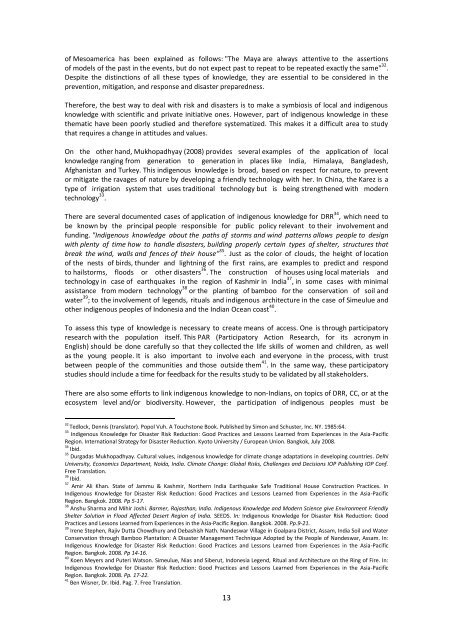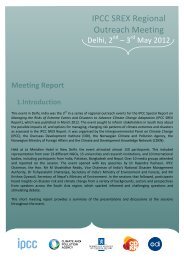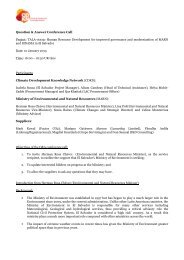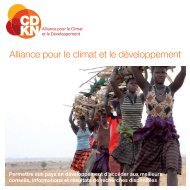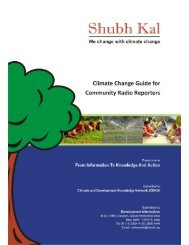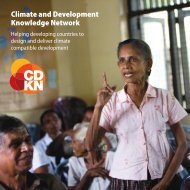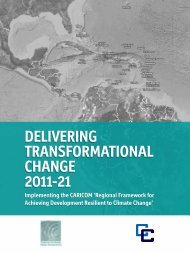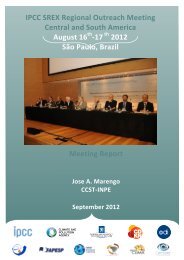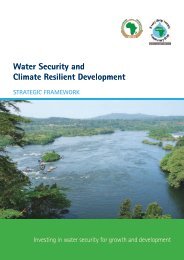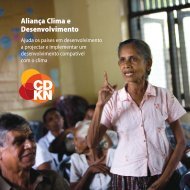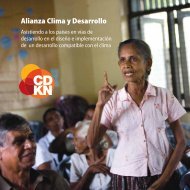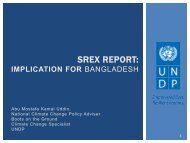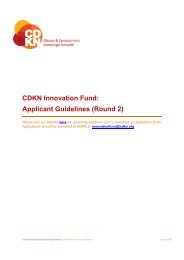of natural resources are some of the major current problems, as these can often be done withinindigenous territories, without prior consultation of the people involved.However, the effects of degradation and environmental disasters, management of biodiversity andecosystems are specific areas in which indigenous people can contribute their knowledge to thecommunity resilience. In a brief literature review, indigenous peoples have their own knowledge andhave contributed to their own concept of development and sustainability. Given the experience of theregion, we can mention that while in the non-Indigenous point of view, nature must be controlled andexploited, the indigenous point of view of nature is that of a mother who is cherished and respectedbecause she provides and maintains life. In general, indigenous knowledge are diverse, mostly of apreventive nature, based on the components of the surrounding nature, constantly developed by itsown specialists experts, that tend to be female or male elderly, passed from one generation to the nextand with roots in the appreciation of nature, the creation of the world and the spiritualor religious. These bodies of knowledge form a cultural heritage of indigenous wisdom untilnow little known, understood and valued.Some studies have thrown light on different aspects of the issue of indigenous knowledge. To beginwith, we mention that there is much debate on similar concepts, such as traditional knowledge, folkknowledge, and indigenous knowledge and there is no universal consensus on them. For example,conceptually the distinction is made between "indigenous knowledge" and "local knowledge",noticing that the former is included in the second 27 . It is said that local knowledge includes a greaternumber of people and communities who live in rural or urban areas. It is knowledge acquiredthrough practice and experience and is aware of their usefulness because it is said that local knowledge"involves the total of perceptions, beliefs, understandings, and skills that one or more members ofa community use or potentially uses to communicate about and manipulate the world. “World” means inthis sense the physical environment and constructed and also the social, economic and politicalconditions affecting the production and consumption at the local level" 28 .It is also recognized that local knowledge has dynamic characteristics. Ben Wisner (2009) statesthat local knowledge is not entirely “traditional” (handed down from generation to generation) becauseit leads to believe that people have no ability to adapt to new circumstances or contexts. The sameauthor shows that local knowledge is not a "museum of tradition," but is in constant production and thetrend is towards increasing hybridization 29 .Indigenous knowledge is often treated with a short-sighted and superficial approach, which takes awaytheir comprehensiveness. For example, environmental conservation can be identified by thestakeholders/actors collectively in a comprehensive manner including the community and havingcommon sense with the ancient knowledge of the community. In addition, indigenous knowledge isdynamic and is in a differentiated relationship with the outside world, as UNESCO has described,dynamic and evolving - reconstituted, recreated and reviewed by each subsequent generation by theholders of the knowledge 30 .Similarly, indigenous knowledge also implies a political dimension, in the sense of recognizing thepeople's own knowledge, as established in ILO Convention 169 31 . In this context, it is anancestral knowledge, with intergenerational transfer, but this is not unalterable before the changes intime and circumstances. Part of it lies in the philosophical ways of thinking about time, which is not onlya linear opposition against the cyclical. For example, the notion of time among the Maya peoples27 Durgadas Mukhopadhyay. Indigenous Knowledge and Construction of Safe School Buildings for Combating Disasters. Theme:Community Preparedness for Disaster Prevention and Response. Sparta Institute of Social Studies.International Conference on School Safety (A Golden Jubilee Initiative) 14-16 May 2008, Islamabad, Pakistan.28 Ben Wisner, Dr “Local Knowledge and Disaster Risk Reduction”. Keynote. Side Meeting on Indigenous Knowledge <strong>Global</strong>Platform for Disaster Reduction, Geneva, 17 June 2009. DESTIN, London School of Economics; Aon Benfield Hazard ResearchCentre, University College London; Environmental Studies Program, Oberlin College, USA. Pag. 1.29 Ben Wisner, Dr. Ibid. Pag. 2-3.30 UNESCO, “Safeguarding the Transmission of Local and Indigenous Knowledge of Nature”. Working document for expertsmeeting, (Nagoya, Japan, 14-15 April 2005). Free translation.31Convention concerning Indigenous and Tribal Peoples in Independent Countries (Note:Date of entry into force: 05:09:1991.)http://www.ilo.org/ilolex/spanish/convdisp1.htm12
of Mesoamerica has been explained as follows: "The Maya are always attentive to the assertionsof models of the past in the events, but do not expect past to repeat to be repeated exactly the same" 32 .Despite the distinctions of all these types of knowledge, they are essential to be considered in theprevention, mitigation, and response and disaster preparedness.Therefore, the best way to deal with risk and disasters is to make a symbiosis of local and indigenousknowledge with scientific and private initiative ones. However, part of indigenous knowledge in thesethematic have been poorly studied and therefore systematized. This makes it a difficult area to studythat requires a change in attitudes and values.On the other hand, Mukhopadhyay (2008) provides several examples of the application of localknowledge ranging from generation to generation in places like India, Himalaya, Bangladesh,Afghanistan and Turkey. This indigenous knowledge is broad, based on respect for nature, to preventor mitigate the ravages of nature by developing a friendly technology with her. In China, the Karez is atype of irrigation system that uses traditional technology but is being strengthened with moderntechnology 33 .There are several documented cases of application of indigenous knowledge for DRR 34 , which need tobe known by the principal people responsible for public policy relevant to their involvement andfunding. "Indigenous knowledge about the paths of storms and wind patterns allows people to designwith plenty of time how to handle disasters, building properly certain types of shelter, structures thatbreak the wind, walls and fences of their house” 35 . Just as the color of clouds, the height of locationof the nests of birds, thunder and lightning of the first rains, are examples to predict and respondto hailstorms, floods or other disasters 36 . The construction of houses using local materials andtechnology in case of earthquakes in the region of Kashmir in India 37 , in some cases with minimalassistance from modern technology 38 or the planting of bamboo for the conservation of soil andwater 39 ; to the involvement of legends, rituals and indigenous architecture in the case of Simeulue andother indigenous peoples of Indonesia and the Indian Ocean coast 40 .To assess this type of knowledge is necessary to create means of access. One is through participatoryresearch with the population itself. This PAR (Participatory Action Research, for its acronym inEnglish) should be done carefully so that they collected the life skills of women and children, as wellas the young people. It is also important to involve each and everyone in the process, with trustbetween people of the communities and those outside them 41 . In the same way, these participatorystudies should include a time for feedback for the results study to be validated by all stakeholders.There are also some efforts to link indigenous knowledge to non-Indians, on topics of DRR, CC, or at theecosystem level and/or biodiversity. However, the participation of indigenous peoples must be32Tedlock, Dennis (translator). Popol Vuh. A Touchstone Book. Published by Simon and Schuster, Inc. NY. 1985:64.33 Indigenous Knowledge for Disaster Risk Reduction: Good Practices and Lessons Learned from Experiences in the Asia-PacificRegion. International Strategy for Disaster Reduction. Kyoto University / European Union. Bangkok, July 2008.34 Ibid.35 Durgadas Mukhopadhyay. Cultural values, indigenous knowledge for climate change adaptations in developing countries. DelhiUniversity, Economics Department, Noida, India. Climate Change: <strong>Global</strong> Risks, Challenges and Decisions IOP Publishing IOP Conf.Free Translation.36 Ibid.37 Amir Ali Khan. State of Jammu & Kashmir, Northern India Earthquake Safe Traditional House Construction Practices. InIndigenous Knowledge for Disaster Risk Reduction: Good Practices and Lessons Learned from Experiences in the Asia-PacificRegion. Bangkok. 2008. Pp 5-17.38 Anshu Sharma and Mihir Joshi. Barmer, Rajasthan, India. Indigenous Knowledge and Modern Science give Environment FriendlyShelter Solution in Flood Affected Desert Region of India. SEEDS. In: Indigenous Knowledge for Disaster Risk Reduction: GoodPractices and Lessons Learned from Experiences in the Asia-Pacific Region. Bangkok. 2008. Pp.9-21.39 Irene Stephen, Rajiv Dutta Chowdhury and Debashish Nath. Nandeswar Village in Goalpara District, Assam, India Soil and WaterConservation through Bamboo Plantation: A Disaster Management Technique Adopted by the People of Nandeswar, Assam. In:Indigenous Knowledge for Disaster Risk Reduction: Good Practices and Lessons Learned from Experiences in the Asia-PacificRegion. Bangkok. 2008. Pp 14-16.40 Koen Meyers and Puteri Watson. Simeulue, Nias and Siberut, Indonesia Legend, Ritual and Architecture on the Ring of Fire. In:Indigenous Knowledge for Disaster Risk Reduction: Good Practices and Lessons Learned from Experiences in the Asia-PacificRegion. Bangkok. 2008. Pp. 17-22.41 Ben Wisner, Dr. Ibid. Pag. 7. Free Translation.13
- Page 3 and 4: Executive SummaryCentral America is
- Page 5 and 6: Central is located in the "Ring of
- Page 7 and 8: Study ContentAs an innovative theme
- Page 9 and 10: that coexist in the universe. This
- Page 11: Central America level, is the only
- Page 15 and 16: possesses effective cultural commun
- Page 17 and 18: Additionally, to succeed and achiev
- Page 19 and 20: eforestation, hydrological planning
- Page 21 and 22: General thematic introduction on Cl
- Page 23 and 24: Central American Governments should
- Page 25 and 26: projected 109 conditions, changes o
- Page 27 and 28: General introduction on the themati
- Page 29 and 30: participatory manner, to address di
- Page 31 and 32: Causes and complementary consequenc
- Page 33 and 34: Organizational and legal contextWhi
- Page 35 and 36: The three bodies within the SICA ar
- Page 37 and 38: Based on research of available info
- Page 39 and 40: SE-CONREDCivilProtectionSNETCCNISCO
- Page 41 and 42: Synergy model that displays the add
- Page 43 and 44: Added value of indigenous and local
- Page 45 and 46: They do not work in a separate mann
- Page 47 and 48: demand for agricultural raw materia
- Page 49 and 50: Amazon DIPECHO Project “Strengthe
- Page 51 and 52: Indigenous Knowledge on DisasterMit
- Page 53 and 54: The combination of indigenous andsc
- Page 55 and 56: Indigenous Skills and the mysticism
- Page 57 and 58: Weather forecast through indigenous
- Page 59 and 60: In various international convention
- Page 61 and 62: Recommended ReadingBennett, A., 200
- Page 63 and 64:
ILO, 1993, Convenio sobre pueblos i
- Page 65 and 66:
Local knowledgeIncludes people and
- Page 67 and 68:
which are threatswith a certainprob
- Page 69 and 70:
Appreciates and respects their orga
- Page 71 and 72:
framework, without taking into acco
- Page 73 and 74:
Currently Cacaopera ethnicity, alth
- Page 75 and 76:
IDH 228 For 2007 is of 0.6999Politi
- Page 77 and 78:
The Mayangnas are people who are de
- Page 79 and 80:
Rights of detainees to receive info
- Page 81 and 82:
Heritage Protection Article 128The
- Page 83 and 84:
19/09/1996 Law no. 230 Amendments a
- Page 85 and 86:
Indigenous Population:IDH 241 In 20
- Page 87 and 88:
Honduras, each has a different orig
- Page 89 and 90:
MISQUITOS 248 :In 1996 there were 3
- Page 91:
Internationalconventions signed wit


